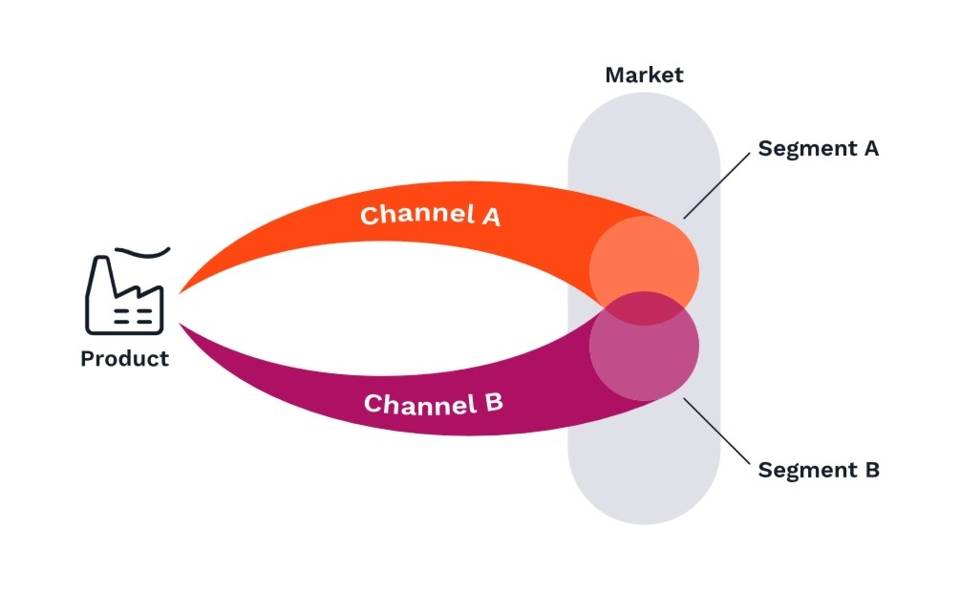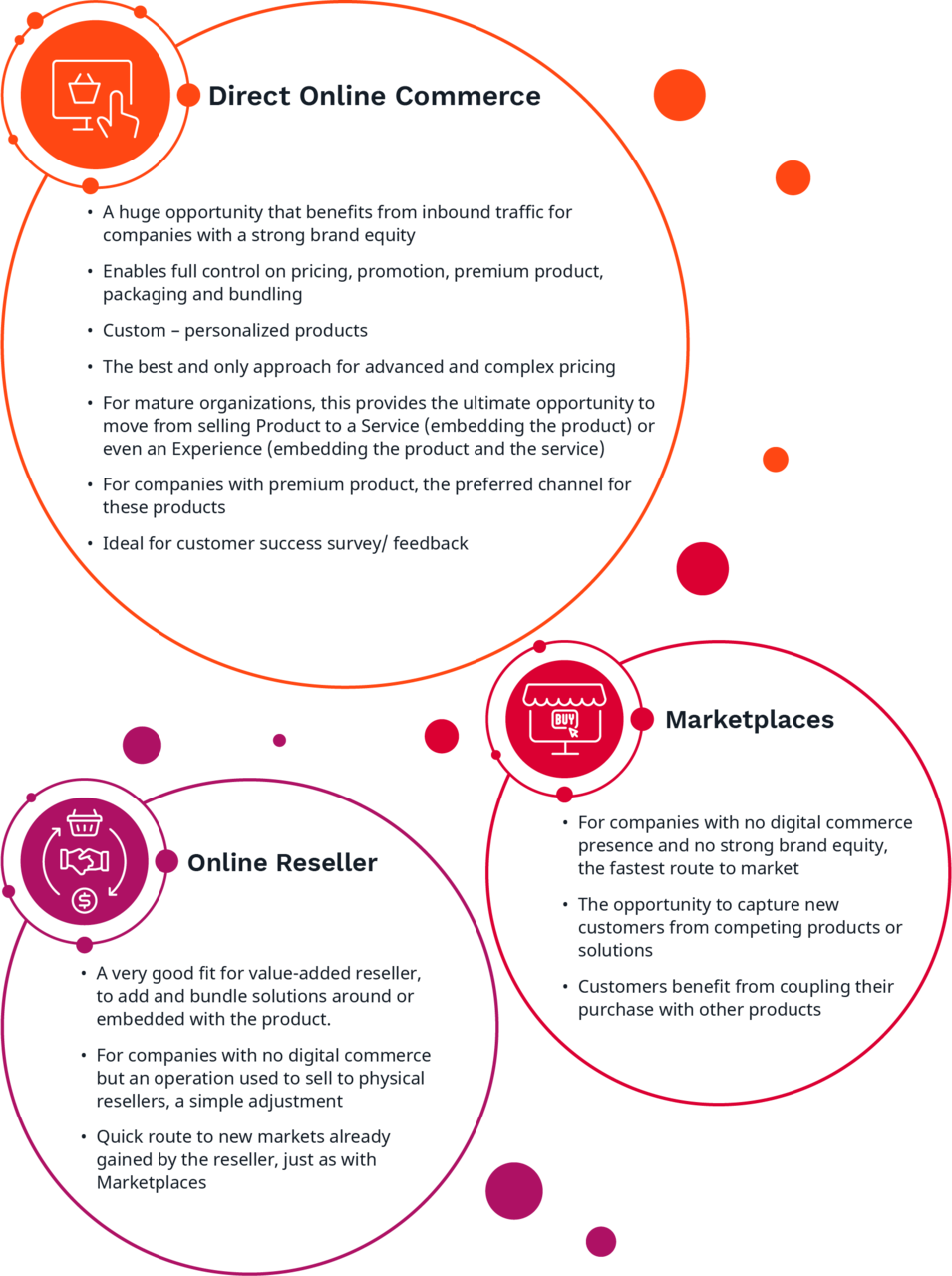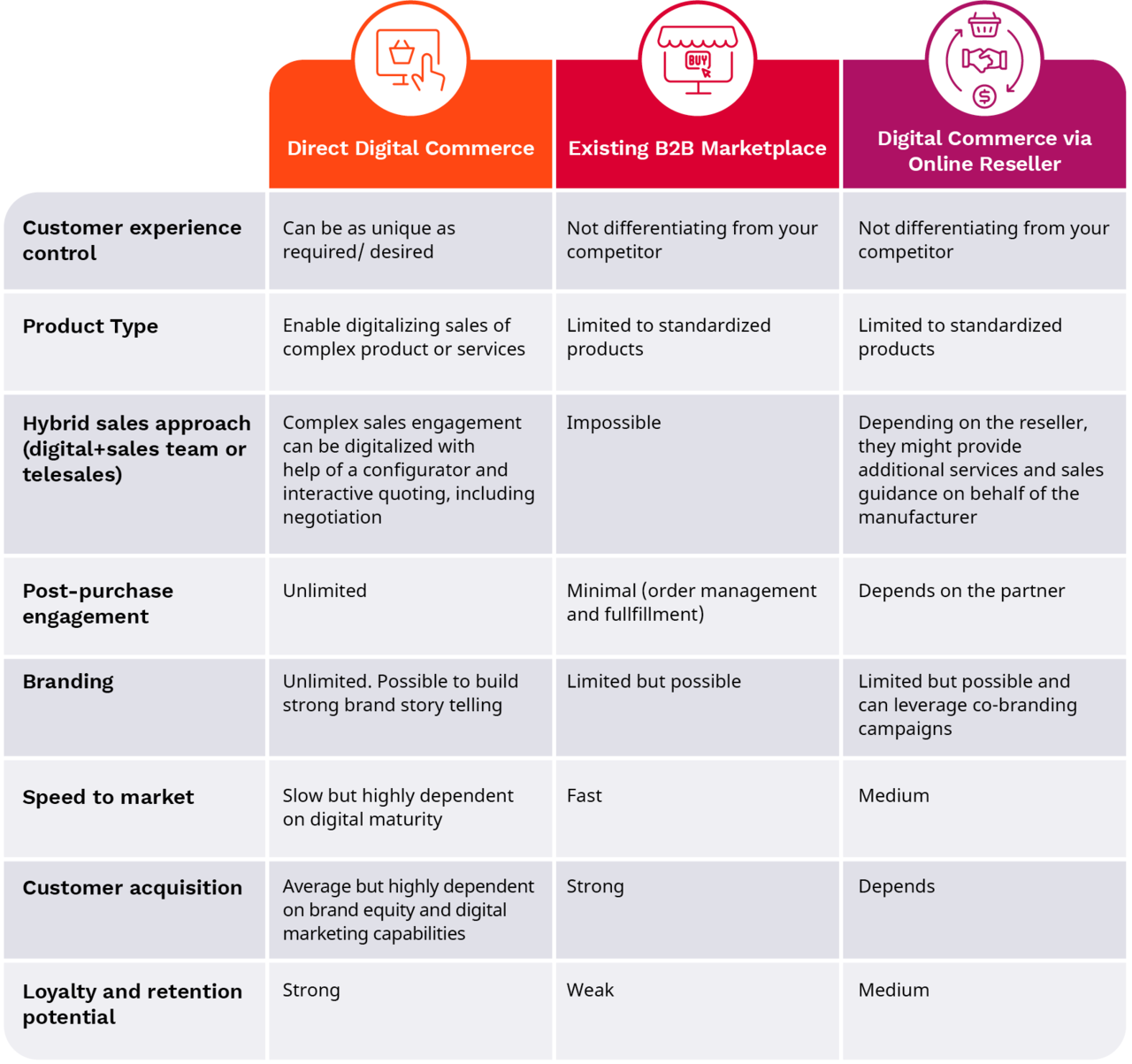Diversifying Your Sales Channels With Digital: Understanding Dynamics, Risks and Opportunities
Today, B2B buyers purchase through an increasingly diverse array of channels and markets. This digital shift means that businesses need to place a greater emphasis on an omnichannel customer experience and the implementation of effective self-serve channels if they're to remain competitive. Digitalizing your sales strategy is an essential part of this process. It involves adapting your existing sales channels to new digital realities and exploring new, emerging channels, too.
In this article, we take a look at how to digitalize your current sales channels and consider why exploring new opportunities is beneficial for your business, as well as the pitfalls you must avoid.
The omnichannel customer experience - new ways of reaching customers
Thanks to the emergence of new digital technologies, businesses have never had so many ways of reaching out to customers. The development of the internet continues to cause drastic shifts in consumer behavior; digitally savvy businesses have been taking advantage of these new opportunities for a considerable amount of time.
While new communication channels and fresh sales and distribution models are an overwhelmingly positive development for those businesses able to capitalize on them, they can be confusing. There's a lot of them, they can be complicated, and their success often depends on adopting new technology.
Though diversification of sales channels is not new, and has been a common phenomenon throughout much of modern business history, the digital revolution accelerated the speed at which this diversification took place. New "digital channels," such as websites, email, apps, social networks, and kiosks, were developed and came to prominence rapidly, giving businesses relatively little time to adapt.
Case Study: Rapid digital diversification - Amazon
Amazon is an excellent example of how digital technology has created new sales channels, models, and opportunities for businesses to explore and exploit.
With the help of emerging digital technologies - many of which the company itself innovated - Amazon went from being an online bookstore to one of the biggest companies in the world within 20 years, and a lot of that came from this appetite to diversify. At the same time, it revolutionized commerce, changing established business models at a remarkable speed.
While Amazon was launched and operated many years under a traditional e-Commerce model (owning inventory and taking responsibility of the supply chain), it introduced relatively recently the marketplace model used by others such as Alibaba, as a complement of its “traditional e-Commerce” business. This model is not so different from a traditional "agent" sales channel. Like an agent, the Amazon marketplace does not own or purchase the products sold. Instead, it facilitates sales, generating revenue in the process.
This new digital sales channel has proven so successful that a whole new industry has built itself around the process of maximizing revenue in the Amazon marketplace. In other words, "middlemen" businesses now play a prominent role in helping other companies make the most of the channel.
With a comprehensive understanding of the science of selling through Amazon, as well as digital marketing, they maximize a business's performance in the channel, despite having little-to-no bond to the products they're helping to retail.
Channel overlap and the risk of cannibalizing existing sales channels
While the emergence of a wide range of new, digital channels and markets presents many opportunities, there are also several risks. One of the most significant risks for businesses is channel overlap or the cannibalizing of existing sales channels. Again, this is not a new phenomenon and was a recognized issue before the digital revolution. However, the risks associated with channel overlap are greatly amplified by digital technology.
Every channel your business uses addresses a particular segment of your market. When two channels overlap and target the same customers, it can result in conflict and confusion. It's important to note that overlap isn't necessarily negative but that there are two critical implications to consider:
- Channel overlap may not harm your business if the channels are distinct and the difference is clear to your customers, as they'll continue to purchase your products. However, it might hurt the intermediaries in your channel - your distributors, agents, brokers, etc. Forced to compete with another sales channel, they might decide to reduce their involvement and commitment to your business or change the rules and terms of your collaboration. This can damage your bottom line.
- If channel overlap confuses your customers, your business will suffer. When your products or services are available in different ways, via different channels, you can introduce discrepancies, differences, and confusion. This will directly impact your customer experience and, as a result, your sales performance.
Case Study: Confusing channel overlap damages business - Renault
As an example of how channel overlap can damage your bottom line, we’re going to take a look at Renault. While this example focuses on pre-digital sales channels, the lessons drawn from it are very much applicable to e-commerce.
The car manufacturer Renault has owned and operated a traditional retail channel (Renault Retail Group - RRG) since 1898. This channel runs in parallel with an extensive network of franchised car dealers. This was confusing for customers and resulted in considerable conflict between the two channels. Effectively, two of Renault's biggest sales channels were competing against one another rather than operating cooperatively and collaboratively.
This conflict was so debilitating that RRG was forced to transform its sales model. Now, the company is investing much more in its digital presence to minimize friction with the franchise network.
Reaping the benefits of an omnichannel customer experience
So far, we’ve looked at the risk inherent in opening up new digital sales channels. However, the emergence of a wide range of new sales channels is also an opportunity.
When channels are designed to reach different segments of the market, the benefits can be enormous. Harnessing new communication channels can also provide access to new demographics that are not addressed by other channels. For instance, social media lets you reach an entirely different set of buyers than a traditional storefront on the high street.
If your business is considering expanding into new digital channels, you should question whether the added value of a new channel is greater than the potential damage to existing channels.
Case Study: A controlled omnichannel customer experience gets results - Hummel
Hummel is a Danish sports clothing brand that decided to launch a digital transformation project focused heavily on controlling and managing its brand across all channels. This involved introducing a consolidated e-commerce approach across both its B2B and B2C channels.
While the opening of direct-to-consumer (D2C) sales channels could have hurt Hummel's relationship with B2B customers who resell its clothing, the opposite occurred. Following the transformation, Hummel's B2B sales volumes actually increased by a greater margin than its B2C sales figures. Rather than resulting in channel cannibalization, the move expanded the brand's reach and made it a more attractive proposition across all channels.
By using an omnichannel digital strategy that emphasized intelligent brand development, its digital channels added greater value than the financial damage potential channel conflict could inflict. This makes it one of the best omnichannel experience examples available to businesses who want to diversify their digital channels.
Finding the ideal blend of channels
Now that we understand the risk and reward inherent in channel diversification, it’s time to look at how your business can find a good balance of channels. To do so, we’ll need to examine a few of the major digital channels and models that have risen to prominence in recent years.
- Direct Digital Commerce is when you operate your own e-commerce channel to reach your end customer. This can be a channel that sells direct to the consumer (D2C), a business (D2B or direct-to-business), a governmental organization, or a range of other parties. Put simply, you are creating a direct connection to the final buyer of your product via digital commerce
- Existing B2B Marketplace is an external sales channel where a third-party player (the marketplace operator) connects you (as well as your competitors) to your customers and acts as an agent or middleman facilitating the sale
- Digital Commerce via Online Reseller is another type of go-to-market channel where you don't disrupt the value channel but count on your distributor or resellers to sell to their customers online. With this approach, your focus is selling to your reseller or distributor while also providing digital tools to help them sell to the end customers. This typically occurs through minisites, e-retailing, and find-a-reseller functionality.
The table below explains some of the main differences between these three approaches:
For most companies, these three channels can be utilized in a way that minimizes channel cannibalization, extends the reach of your brand, and maximizes sales. Where there is overlap - i.e., between a direct online sale and a sale made through an online reseller - it's essential to consider the effect of the conflict on all those involved. In most cases, this means your business, your customers, and your partners.
All channels are capable of adding value and are good candidates for your sales channel mix. Many possible routes can be explored, considered, and built. However, you must avoid implementing a whole host of new channels at once. Instead, design a "digitization roadmap" and focus on building up your digital presence bit by bit. This allows you to optimize each channel's performance before moving on to the next. It also ensures you're able to identify and isolate problems far more easily.
It’s also important to think about the benefits of each type of digital channel.
Three considerations for the best omnichannel customer experience
To help you create a digital channel diversification strategy, we've identified three key considerations that should influence your decision-making.
- Brand, brand, brand You need to control your brand across all channels and in all communications you have with customers and partners. As we elaborated in an earlier post, building a consistent brand is crucial for your digitization strategy.
Begin by focusing your efforts on creating a digital content hub and mastering the different workflows that contribute to your content creation and distribution processes. The key here is developing effective content management, content strategy, content operation, and workflows.
Remember - the stronger your brand, the easier it is to make your channels work together without suffering from channel cannibalization.
- Product considerations As a business, you need to match what you’re selling to the right sales channels. Do you sell high or low consideration products? Are they simple or complex?
Simple products are well suited to online marketplaces, as there's not a vast amount of additional information you need to communicate to sell the commodity. If you benefit from significant brand reach, your products will stand out in the marketplace and won't suffer too much from being listed side-by-side with the competition.
On the other hand, if your product is complex or considered unique, your prospective customer probably won't search for it in the marketplace. Instead, they'll look to a channel that allows the seller to demonstrate their expertise better and communicate important product information. These customers will often demand a close dialog with your business, whether that's via employee-staffed or self-service channels, as they'll want to ask you questions, seek advice and develop a more in-depth professional relationship.
- Current sales channels
The final consideration is the way you sell your products and services now. What channels do you use, and how are they performing?
For instance, if you sell indirectly via a network of distributors and resellers, it's more challenging to introduce new channels without affecting your existing sales channels. One way of doing so might be first to digitalize this existing sales channel without changing its model. Introduce automation technologies and self-service for parts of the sales process, to complement and improve the work of your sales team.
If you don't have strong constraints on your sales model and your sales performance is too low or hitting its limits, then there's nothing blocking you from reinventing your sales channels or selling directly through the Cloud. A fantastic example of this type of pivot comes from Adobe, which went from selling desktop software through traditional software sellers to direct sales on the Cloud via its "Creative Cloud" channel.
A progressive digital transformation that’s driven by business value
Your digital diversification strategy will largely depend on your particular circumstances and will often be unique to your business.
For instance, pushing inventory on a marketplace is usually the fastest route to market for those companies that are not ready to operate their own e-commerce operation and/ or do not have a strong online reseller in their given market.
In this context, your first step could be to publish your entire product catalog on a marketplace, ensuring a digital route for customers. At the same time, you could begin developing a direct digital e-commerce channel. Once established, you would make premium or companion products exclusive to the direct channel (or to a value-added reseller) as a means of drawing customers from the marketplace to the direct channel.
This strategy is not easy to pull off, and the marketplace operator will certainly not facilitate it. After all, you're moving customers away from their revenue stream. However, it is achievable through intelligent channel building and effective branding.
For those companies that have already established solid digital and physical sales channels, it might be wiser to focus on digital branding and marketing before launching another e-commerce channel.
Ibexa DXP facilitates excellent omnichannel experiences and customer journeys
In general, effective digital transformation is about innovation. Innovative companies experiment with different options to identify which work and which don’t. They make this assessment based purely on customer value and customer experience. Like any experiment, innovation is a science. It involves controlling costs, being agile from both a business and a digital perspective, and adapting to ever-changing conditions.
At Ibexa, we provide a Digital Experience Platform that helps companies digitize their sales strategy. Among other capabilities, it empowers your business to explore all possible channels, personalize content to specific audiences and manage a genuinely omnichannel sales system. Thanks to the strong personalization capabilities and customizable experience platform bundled with the package, Ibexa DXP provides you with the tools and features you need to build frictionless and memorable customer experiences.
If you are interested in exploring more about our offering, don't hesitate to contact us
Considerations for Creating Rich Customer Experiences
DXP eBook
If you are struggling with your B2B digital transformation efforts, why not reach out to us to discuss your project. Feel free to download and read Ibexa's eBook on Digital Experience Platforms and the four considerations for creating exceptional customer experiences.




